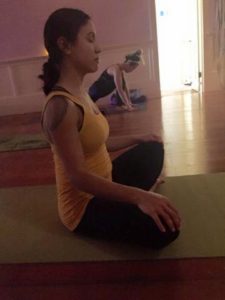Guided Imagery Meditation
Guided meditation aims to calm the nervous system, help decrease stress and tension in the body and mind, and bring people into the deep place within themselves that is at perfect peace in all situations. The more often we practice meditation, the more likely we are to handle challenges, obstacles, and difficult emotions in a calm and productive way, responding from that place of peace rather than from our raw emotions and feelings. Guiding meditation is the art of speaking, word choice, and practice, and results in a connection first between the person guiding and the meditator, then in a connection between the meditator and her body, breath, and mind, and finally between the meditator and her fully contented self.
When I speak out loud in meditation, I keep my voice rhythmic and light, yet audible. Often words seem to blend one into the other to draw the meditators attention fully into the present moment, my voice becoming the first point of focus to allow for a letting go of thoughts. I use simple language and physical description to further draw attention to the here and now. I pause between phrases to give time for the mind to process the words and respond with body and breath. Once the meditator has connected to body and breath, I choose words to help emphasize acknowledging thoughts without judgement and letting the thoughts go. Yogic philosophy states that we are not our thoughts. We think and we often act based on thoughts and feelings rather than based on the perfect peace within because it takes practice to find that peace, and our feelings and thoughts are right there on the surface. Meditation seeks to help people let go of our fleeting and illusionary thoughts and feelings and tap into our place of perfect peace.
In some modes of meditation, the meditator is guided to keep drawing the attention to body and breath, letting go of whatever is in the mind in order that the mind might find clarity through perfect peace. In guided imagery, however, the meditator is asked to engage the intellect and the imagination, imagining that he is in a place, sometimes walking from a place of discomfort to a place of comfort, other times immediately placed into comforting places, like a boat on water, waves slowly moving the boat along. Perhaps the sun is warm, and there’s a soft breeze upon the skin. Maybe I’ve asked you to imagine your bare feel upon smooth stones, cool water lapping your ankles. Whatever the image, I provide some detail, and the meditator fills in the gap with whatever additional details my guided imagery evokes.
When we invoke imagination, our focus shifts from thoughts and feelings to an imagined place. It’s not that our thoughts and feelings aren’t still there, but rather that we shift our perspective. This is why before guiding image, I encourage acknowledging thoughts without judgement. If we are judging our thoughts, this judgement will distract us from the guided image. In turn, when we allow ourselves to be fully taken to a new place, thoughts and judgement naturally release. We cannot pay attention fully to two things at once, so either we will remain in our own thoughts, or we will shift our thoughts to a new place. Once in the new place, it can be easier to find peace than it might be returning again and again to body and breath and the attempt to let go of the mind. Imagery allows us to engage the mind in childlike play.
Peace either comes or eludes us depending on our ability to surrender to guidance. The guidance is simply there to bring us closer to what’s already within. None of us wants to struggle, to be sad or mad, to be in turmoil, harboring tension in our shoulders or hips, circling the same negative thoughts over and over again. We all want peace, and when we learn that this peace only comes from within and that we will not find it from anything outside ourselves—other people, objects, or money—we can begin to surrender to what is, let go of what we cannot control, and imagine a place of peace that with practice becomes real.
Peace. Namaste.
